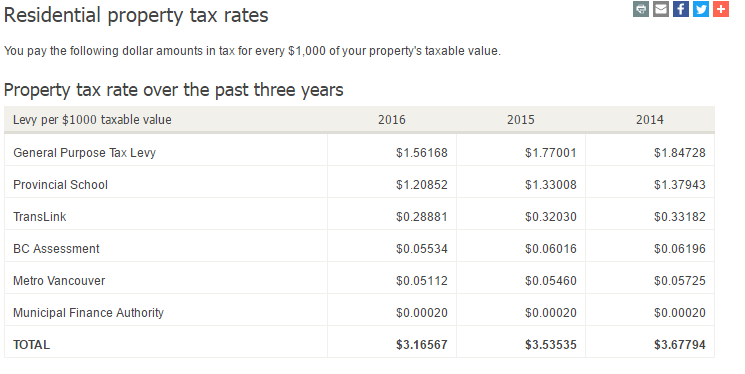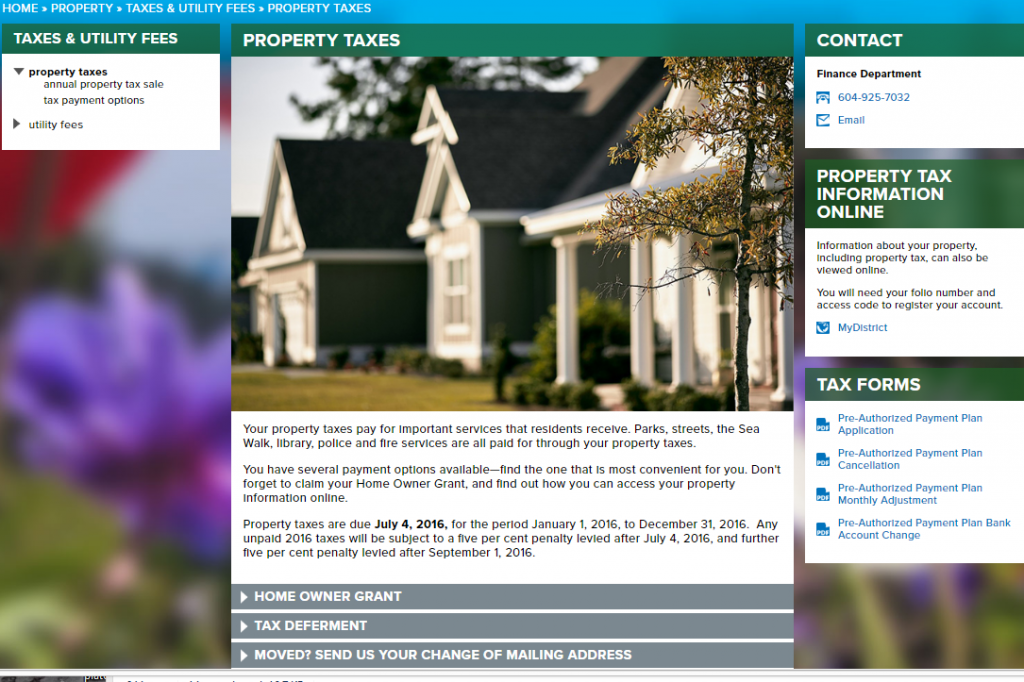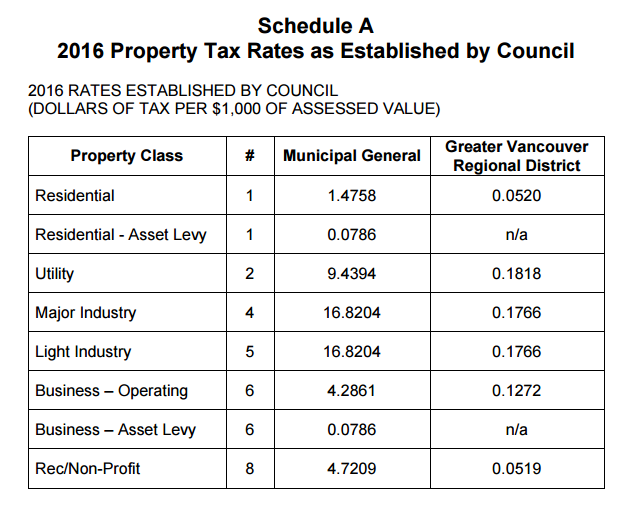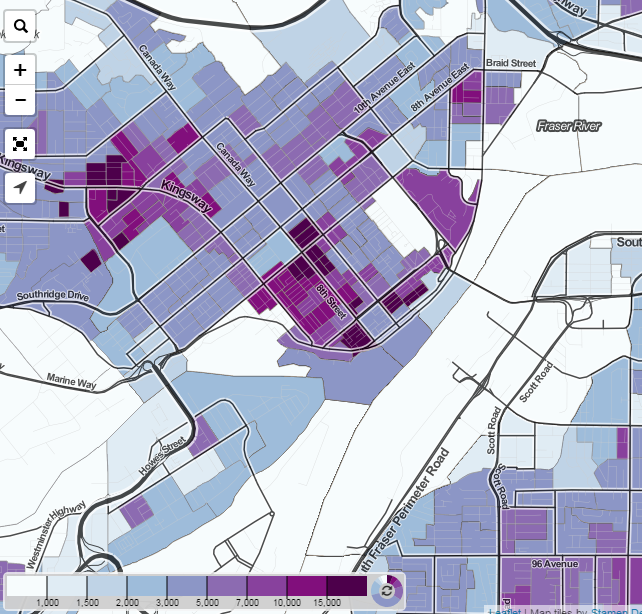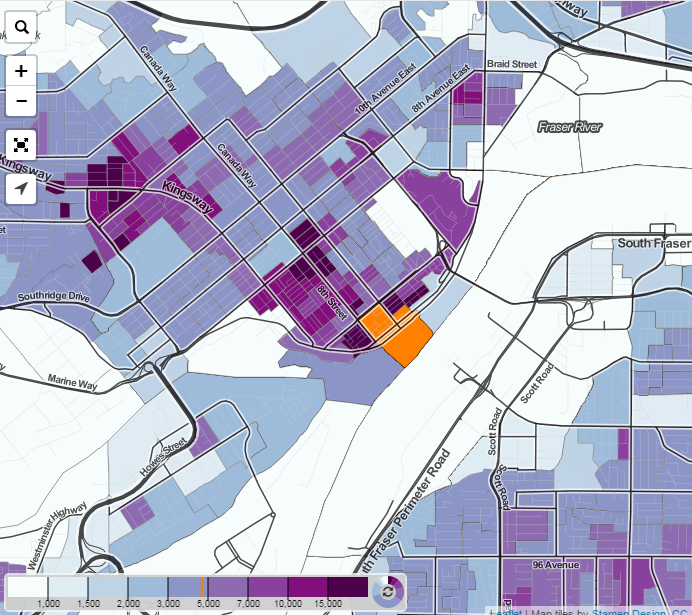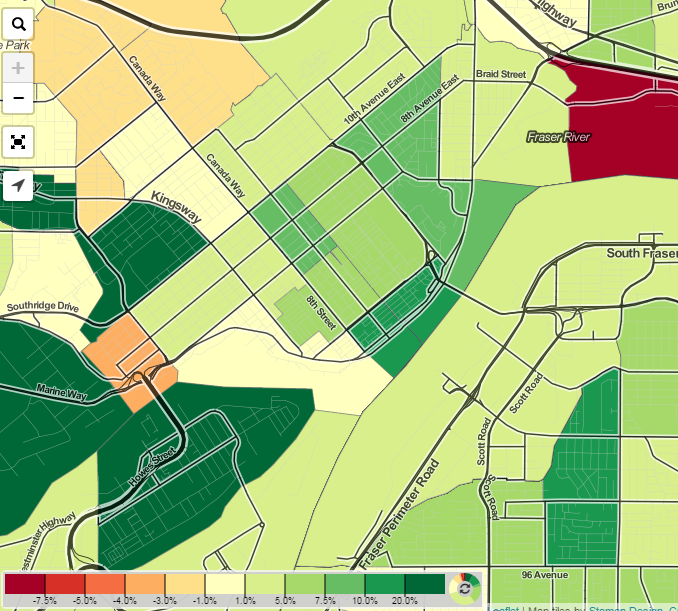Our Council meeting on May 1st was another long one, as a large number of delegates came to speak to the proposed Heritage Conservation Area for Queens Park. Again, if this proposal moves forward, it will be going to Public Hearing, so do not take Council’s cautious approach to responding to delegates’ direct questions as disinterest, but more an acknowledgement that there is still much discussion to have in the neighbourhood and community before Council makes any decision here.
The regular agenda began with a couple of presentations and reports.
Arrival of EVO Car Sharing in New Westminster
This announcement is important to New Westminster because it supports the policy goals of our Master Transportation Plan by reducing vehicle reliance in the City, encouraging active transportation choices, and making transportation in our city more affordable for more people.
The presentation and report outlined the various ways Car sharing support these goals. Every car-share vehicle correlates with the reduction of 5-11 private vehicles, reducing the need to accommodate cars through parking and road space. For many users, it is more affordable than owning a car, and supports increased use of transit, cycling and walking. I was amazed that there are already more than 500 EVO members in New Westminster, before they even brought any cars here.
The following items were Moved on Consent:
Request for License to Occupy – Quayside Community Board
The QCB has a large yard sale / festival in the summer, which brings in merchants from around the region to activate the boardwalk. The construction ongoing on the waterfront has created a bit of a challenge for them, and there is an underutilized space at the west end of the Quayside. Although the property is owned in partnership with Metro Vancouver, staff have been working with the QCB to provide a one-day license to allow their merchants to park their vehicles there during the boardwalk sale. Liability and licensing issues abound, but it sounds like all three partners are on side here and have worked through most of it.
1102, 1110, 1116 and 1122 Salter Street: Official Community Plan
Amendment and Rezoning to Allow a 78 Unit Residential Development, Park and Road Dedication – Bylaws for First and Second Readings
This large family-friendly development in Queensborough will have a variety of housing forms, and result in road and park dedication to the City. Council moved to give the OCP and RZ first and second reading, and send the project to Public Hearing. I’ll hold my comments until then.
The following items were Removed form Consent for discussion:
Provincial Property-based Taxes in the Metro Vancouver Region
This is a report for information, you can read it here. Short version: people living in the Metro Vancouver pay more taxes to the Provincial government, in raw numbers and per capita, than the rest of the province. This is especially true of school taxes where the Mil Rate is flat across the province.
Street Naming Bylaw for ‘Mabel Street’ in Queensborough – Bylaw for
Three Readings
I am in favour of this motion, and am comfortable moving forward with this naming, but took the time to suggest to my Council colleagues that the Street Naming Policy that underlies this choice needs to be updated.
Perhaps this conversation can wait until we hear back from staff on the recommendations of the Truth and Reconciliation Commission (following on our April 10th motion), but as a rule our street names disproportionately acknowledge the European settler experience, and probably fail to recognize the diversity of our history.
As a point of discussion, it may be interesting to discuss why streets named after men generally use surnames, and streets named after women fall to the given name…
630 Ewen Avenue (Affordable Housing Project): Housing Agreement
Principles – for Endorsement
The city is working with a not-for-profit to develop a small supportive family housing project in Queensborough. This agreement will set out the conditions under which the housing operates, the duties of the operator and rights of the residents (above and beyond those in the Residential Tenancy Act) which make up the “supportive” part of the housing. Council endorsed these principles.
Queen’s Park Universal Washroom Design
Times change, and how we design public buildings change with them. The concession stand in Queens Park needs replacement, as do the attached bathrooms. The new model for these types of facilities on BC (although this has been standard practice in large parts of Europe for a long time) are to make them “gender neutral”, with secure toilet booths open to either gender attached to a common sink/washup/baby changing area. This reduces a variety of barriers, especially with kids and others who need supports to use public facilities, and assures that the rights all persons are protected.
Queen’s Park Heritage Conservation Area: Full Draft of Conservation Area, Administrative Policy, and Design Guidelines
This conversation followed more than two hours of public delegations, mostly on the topic of the proposed HCA. It is clear there are a variety of opinions and a lot of deeply felt convictions about this proposal. Unfortunately, there are also a variety of “facts” being provided, which makes the conversation challenging. We have more work to do.
This report, however, outlines some of the most important aspects of the HCA proposal, as it details the actual process through which permits and approvals would be managed under the proposed HCA, and also provides a draft of the Design Guidelines that would become mandatory under the HCA if approved.
Council was not able to discuss the Design Guidelines in detail, as we had only received them on Monday, and wanted some time to dig through them and have a fuller understanding before we approved them. That discussion will happen in an Open Workshop on May 8th at 4:30 in the afternoon. It will be open to the public as are all Council meetings.
There is some detail in the report, and if you are concerned, you should rely on the report and not my necessarily reduced summary here, but the draft policy looks something like this:
For houses built before 1941 (about 500 of the 700 homes in QP), the house would need a Heritage Alteration Permit (“HAP”) prior to demolition, construction on the front of sides of the house (parts visible from the street), or changes in the roofline. Internal renovations require no extra permitting. The proposed changes would be evaluated based on a transparent “checklist” to determine if the changes would significantly alter the heritage of the neighbourhood, and whether alternative approaches to meeting the owner’s zoning entitlement could be found.
Staff would review these applications, based on a transparent and clear set of standards, and would deny or approve the permit. If the owner is denied a permit, they would be allowed to appeal to Council, who would make the final decision.
All construction on the visible front of the house and replacement buildings would need to meet the Design Guidelines established under the HCA, as approved by staff.
For all other houses, an HAP would only be required for new construction or subdivision of the property. Demo permits and renovations would not require an HAP.
Staff have tried to develop a fee structure that is fair to all residents of the City, and reduced the cost for renovation vs. demolition, in order to further encourage renovation of heritage homes. The process has also been designed to operate as transparently and quickly as possible, with most permits only taking a couple of weeks to get through the process. The evaluation standards and guidelines have been developed though guidance from the Heritage Commission, Technical Review Panel, and Heritage Working Group, but they will not be involved in the review of individual applications.
In the few cases where it will be required, the appeal process will add time – getting on the agenda so Council can have the final say creates scheduling delays – but by delegating authority we simplify the process and make the entire process work faster, more transparently, and at a lower cost to the City and less stress for the homeowner.
Again, these proposals are going to be going to a Public Hearing in June. Best if you let Mayor and Council know what you think through e-mail.
231 Twelfth Street (Gas Works Building): Site Safety and Demolition Process
The building belongs to the province, and the owner is asking us for a demo permit. The building is in terrible condition, and needs to be removed for public safety reasons. It is unfortunate, but the time to save this building was 20 years ago, and it clearly was not a priority. We can move on and start looking at re-purposing this piece of land, which starts with us getting out of the way and giving the province the room they need to remediate the industrial site.
As a City we don’t own a lot of land that isn’t already completely programmed, this is an opportunity for us to acquire a valuable piece of land that links lower 12th to the Brow neighbourhood.
We wrapped the evening, as always, by addressing a few Bylaws:
Official Community Plan (Land Use Designation Amendment) for 1102, 1110, 1116 and 1122 Salter Street Bylaw No. 7916, 2017 and
Zoning Amendment (1102, 1110, 1116 and 1122 Salter Street) Bylaw 7917, 2017
These Bylaws to support a multi-family development in Queensborough was given two readings. The project will be going to Public Hearing on May 29, 2017. C’mon out and tell us what you think!
Street Naming (“Mabel Street” in Queensborough) Bylaw No. 7902, 2017
This Bylaw to name a new street in Queensborough after Mabel Bowell, Queensborough’s first school teacher, was given three readings.
Heritage Revitalization Agreement (1023 Third Avenue) Bylaw No. 7871, 2016 and Heritage Designation Bylaw (1023 Third Avenue) No. 7872, 2016
These Bylaws to support he building of two stacked townhouses and refurbish and protect a heritage home on Brow of the Hill, as discussed at the Public Hearing on November 28, 2016, were adopted. They are the law of the land.
Downtown New Westminster BIA Parcel Tax – Primary Area Bylaw No. 7911, 2017
Downtown New Westminster BIA Parcel Tax – Secondary Area Bylaw No. 7914, 2017
Uptown New Westminster BIA Parcel Tax Bylaw No. 7912, 2107
These Bylaws that allow us to collect taxes on behalf of the City’s three BIAs were adopted. Adjust your behaviors accordingly.
Tax Rates Bylaw No. 7913, 2017
This Bylaw that sets our property tax rate increase for 2017 at 2.98% was adopted. The bill will soon be in the mail.
